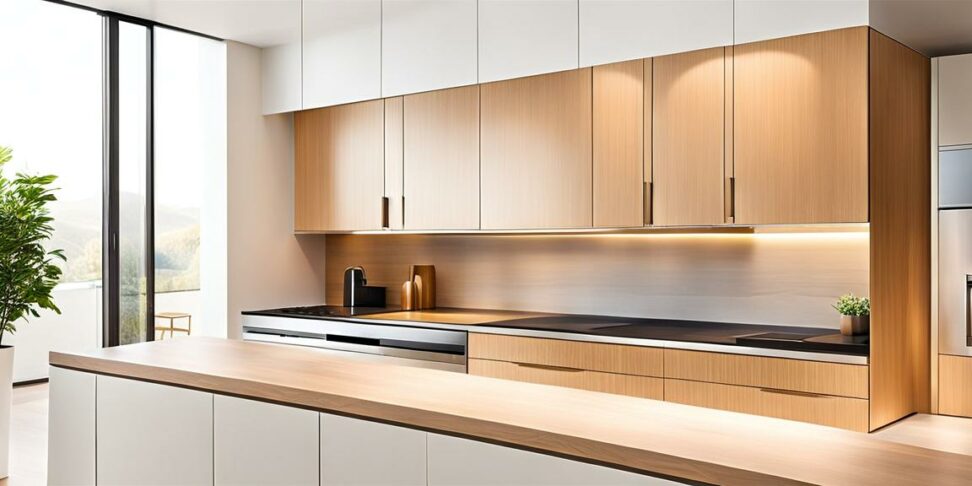Discreet Handle Solutions for a Flawless Minimalist Kitchen
Minimalism is in. That sleek, uncluttered look is the height of modern interior design. And handleless, hardware-free cabinets help achieve that flawless minimalist aesthetic in the kitchen by removing visible handles and knobs.
But while discreet handles create a streamlined look, they require thoughtful design for real-world functionality.
Hidden Hinges Enable Handleless Doors
Eliminating cabinet hardware starts with concealed hinges. Hidden hinges allow cabinet doors to open and close without exposed hinges interrupting their clean lines and surfaces.

What are Hidden Hinges?
Hidden hinges are designed to be concealed within cabinetry frames. When the cabinet is closed, no hinge hardware is visible externally. This allows for handleless cabinet doors that appear to float freely without knobs or poles.
Instead of protruding hinges, discreet mounting plates attach the cabinet door to the frame. Some options rotate 170+ degrees for full articulation.
Benefits of Hidden Hinges
The obvious advantage is their ability to create a handleless, seamless look. Without visible hardware, cabinet surfaces are uninterrupted, creating a sleek, minimalist aesthetic.
Hidden hinges also allow for easier cleaning. Their smooth surfaces don't accumulate grime and grease in crevices like exposed hinges.
Options for Hidden Hinges
Several hidden hinge varieties help realize handleless designs:
- European or concealed hinges fully hide within cabinets.
- Self-closing hinges gently shut doors.
- Soft-closing hinges prevent slamming.
Integrated Pulls Provide Subtle Access
While hidden hinges enable discreet cabinets, some type of handle is still needed to open them. Integrated pulls build grips directly into cabinet doors.
What are Integrated Cabinet Pulls?
Integrated pulls are discreetly built into the front of handleless cabinet doors. Rather than applied knobs or poles, they form subtle grips from the door material itself.
These integrated pulls allow cabinets to maintain their minimalist look while still providing a grip point for opening.
Pros of Integrated Pulls
The main advantage is they preserve a handleless appearance. Cabinets look completely streamlined without visible pulls or knobs.
At the same time, they still provide a subtle grip area for opening cabinets. Different positions give ergonomic options.
Cons to Consider
However, integrated pulls can frustrate some users. Since pulls are less pronounced than knobs, integrated handles are slightly less accessible.
Repairs and adjustments are also more finicky compared to regular cabinet handles. But for those prioritizing a minimalist look, these trade-offs are often worth it.
Types of Integrated Pulls
Varieties include:
- Horizontal grooved pulls cut across cabinet doors.
- Vertical grooved pulls sliced top to bottom.
- Finger notches carved into door edges.
- Edge pulls protruding slightly from doors.
Push-to-Open Mechanisms Hide Away
For a completely handleless look, push-to-open mechanisms conceal all hardware.
What is Push-to-Open?
Rather than visible poles or pulls, push-to-open cabinets use internal spring-loaded hardware. When pressed gently, this mechanism pops the cabinet open automatically.
Benefits of Push-to-Open
Push-to-open maintains a perfectly handleless exterior with no pulls at all. Operation is very satisfying compared to regular cabinets.
They also work well for corner cabinet solutions. The simple press motion provides ergonomic access.
Downsides to Push-to-Open
The main downside is decreased accessibility compared to handles. Pressing discretely with varied hand positions takes practice.
Inconvenience also arises if both hands are full. Without handles, opening cabinets becomes tricky when carrying items.
Best Uses for Push-to-Open
Push-to-open mechanisms work best:
- On lightweight upper cabinet doors.
- For upper cabinets installed out of reach.
Factors To Consider in Your Handleless Kitchen
When planning handleless cabinets, consider:
Accessibility Needs
Assess any physical limitations or disabilities that could impact cabinet access. Open shelving or standard hardware might serve some users better.
Cabinet Contents
Heavy pots and pans may still benefit from having some grip points. Handleless works well for lighting contents like dishes and glassware.
Cleaning Requirements
Hidden hinges prevent dust and grease accumulation in hardware grooves and keep cleaning simple.
Budget
Due to specialized hardware and custom-design, handleless cabinets cost 15-20% more on average.
Aesthetic Goals
If aiming for a contemporary, minimalist look, handleless cabinets can help achieve that seamless style.
Discreet hardware solutions let you realize a flawless minimalist kitchen without sacrificing real-world functionality. Hidden hinges, integrated pulls, and push-to-open mechanisms provide handleless cabinet options suitable for a range of spaces and needs.
With thoughtful design guided by accessibility requirements, handleless cabinets deliver streamlined beauty and ergonomic access.